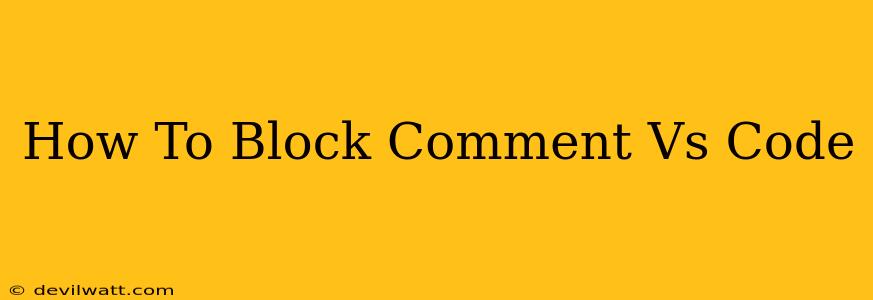Visual Studio Code (VS Code) is a powerful code editor loved by developers worldwide for its versatility and extensive features. One such feature, crucial for debugging, code organization, and collaboration, is the ability to block comment. This guide will walk you through various methods to block comment your code in VS Code, regardless of your programming language.
Understanding the Importance of Block Comments
Before diving into the how-to, let's understand why block commenting is important:
- Debugging: Temporarily disabling large sections of code for debugging purposes is made significantly easier with block comments. This allows you to isolate problematic areas without deleting the code.
- Code Organization: Block comments are invaluable for adding explanations, notes, or descriptions to sections of your code, improving readability and maintainability, especially in larger projects.
- Collaboration: When working on projects with others, block comments help explain your code's logic and intent, facilitating clearer communication among team members.
Methods for Block Commenting in VS Code
VS Code offers several ways to block comment your code, catering to different preferences and coding styles. The specific shortcuts and methods might vary slightly depending on your operating system and configured keyboard shortcuts.
Method 1: Using Keyboard Shortcuts
This is the fastest and most efficient method for many developers. The most common shortcuts are:
- For Linux/Windows:
Ctrl + / - For macOS:
Cmd + /
Simply select the lines of code you want to comment out, and then press the appropriate shortcut. VS Code will automatically add the appropriate comment symbols (// for single-line comments in many languages or /* ... */ for multi-line block comments) to the beginning and/or end of your selection.
Method 2: Using the Context Menu
If you prefer a more visual approach, you can right-click on the selected code and choose "Comment Line" or "Uncomment Line" from the context menu. This offers the same functionality as the keyboard shortcut.
Method 3: Manually Adding Comment Symbols
While the shortcuts are the most efficient, you can always manually add comment symbols to your code. For single-line comments, this often involves typing // before each line. For multi-line block comments, the syntax is usually /* at the beginning and */ at the end of the block. This method is useful for more granular control or when dealing with languages that might require different comment syntaxes. For example:
// This is a single-line comment in JavaScript
/*
This is a multi-line
block comment in JavaScript
*/
/* This is a multi-line block comment in C++ or Java */
Language-Specific Considerations
While the above methods work for many languages, some might have slightly different syntax or require additional plugins. For instance, languages using XML or HTML might require different commenting styles. Always refer to the specific documentation for your chosen language for best practices.
Beyond Basic Commenting: Using Documentation Generators
For more advanced documentation, consider using tools like JSDoc (for JavaScript) or similar documentation generators. These tools allow you to create structured comments that can be automatically converted into comprehensive API documentation, significantly improving code maintainability and collaboration.
Conclusion
Mastering block commenting in VS Code is crucial for every developer. By using the methods outlined above, you can significantly improve your code's readability, maintainability, and the overall development process. Choose the method that best suits your workflow and remember to use comments effectively to make your code clearer and easier to understand.

